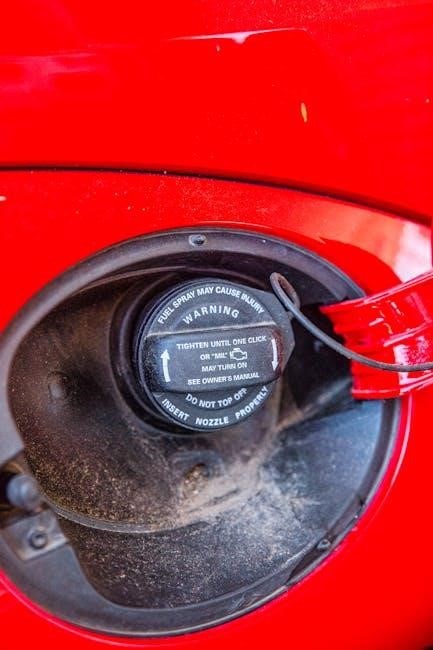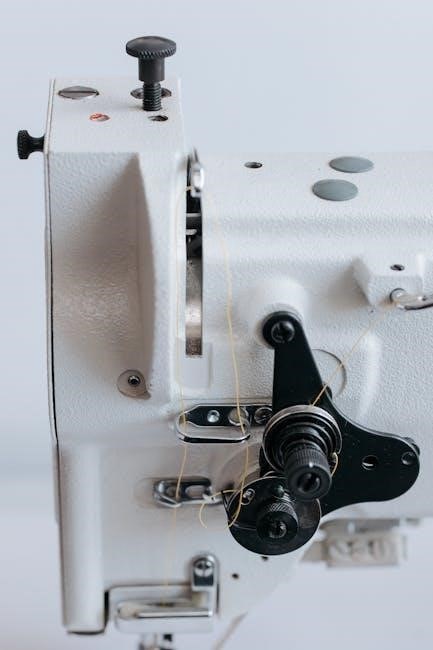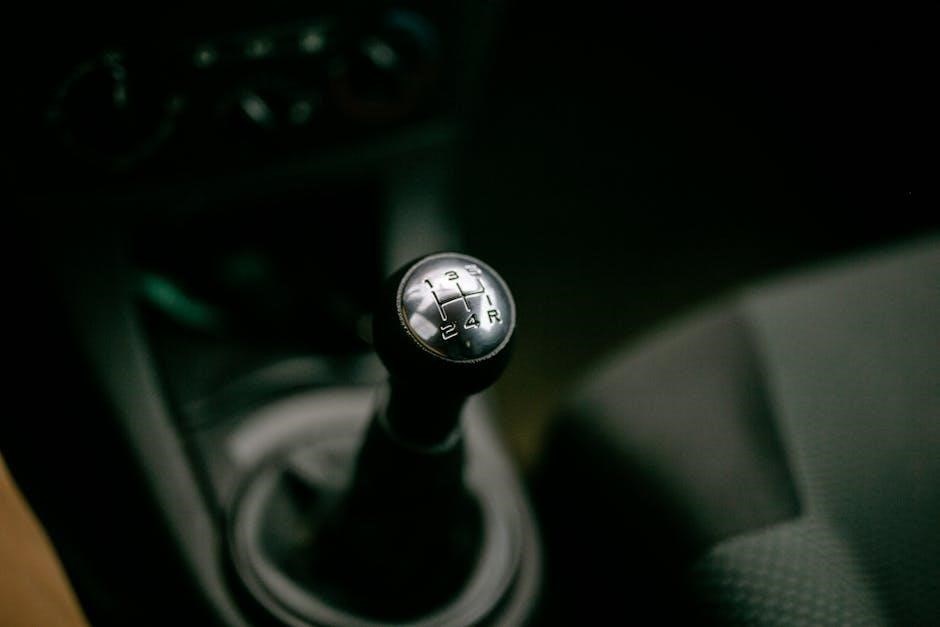The Husqvarna PW3200 Parts Manual is a comprehensive guide for users, offering detailed insights into maintenance, repair, and operation. It ensures optimal performance and longevity of your pressure washer.
Overview of the Husqvarna PW3200 Pressure Washer
The Husqvarna PW3200 is a high-performance pressure washer designed for heavy-duty cleaning tasks. It features a robust 3200 PSI output, making it ideal for industrial and commercial use. Built with a horizontal shaft engine, this model ensures reliability and durability, even under demanding conditions. Its sturdy design and portability make it suitable for large-scale cleaning projects, such as driveways, sidewalks, and equipment. The PW3200 is equipped with a high-pressure pump and efficient cooling system, ensuring consistent performance and longevity. With its versatile nozzle options, users can tackle various surfaces with precision. This pressure washer is a favorite among professionals due to its power, reliability, and ease of use.
The PW3200 also features large wheels and an ergonomic handle, enhancing mobility and reducing fatigue during extended use. Its heavy-duty frame protects internal components, ensuring years of service. Whether for industrial or commercial applications, the Husqvarna PW3200 delivers exceptional results, solidifying its reputation as a top-tier pressure washer in its class.
Understanding the Importance of the Parts Manual
The Husqvarna PW3200 Parts Manual is an essential resource for users, providing detailed information on every component of the pressure washer. It serves as a comprehensive guide for maintenance, repair, and operation, ensuring users can extend the lifespan of their equipment. By understanding the manual, users can identify and replace parts correctly, prevent costly repairs, and maintain optimal performance. It also helps users diagnose issues efficiently, reducing downtime and ensuring safety during operation.
Additionally, the manual empowers users to perform DIY maintenance and repairs, saving time and money. It acts as a valuable reference for troubleshooting and ensures that all safety protocols are followed. Regular use of the manual guarantees that the PW3200 operates at its best, delivering consistent results for years to come.
Key Features of the Husqvarna PW3200
The Husqvarna PW3200 is a high-performance pressure washer with a robust design, delivering up to 3200 PSI of cleaning power. It features a reliable horizontal shaft gas engine for consistent operation and includes durable components built to withstand heavy use. The unit is designed for portability and ease of use, making it ideal for both residential and commercial applications. Its user-friendly interface and versatile nozzle options ensure efficient cleaning across various surfaces. The PW3200 is engineered for long-lasting performance and reliability, supported by Husqvarna’s commitment to quality and customer satisfaction.
Design and Build Quality of the PW3200
The Husqvarna PW3200 boasts a robust and durable design, constructed with high-quality materials to ensure longevity and reliability. Its heavy-duty frame is built to withstand rigorous use, while the horizontal shaft gas engine provides consistent power and performance. The pressure washer features a stainless steel wand and high-pressure hose for added durability. Its portable design includes sturdy wheels and a compact layout, making it easy to maneuver across various terrains. The engine and pump are carefully integrated to minimize vibration and noise, ensuring smooth operation. Husqvarna’s attention to detail in the PW3200’s construction ensures it delivers exceptional performance while maintaining a professional-grade build quality. This design excellence makes it a reliable choice for both homeowners and professionals seeking a durable pressure washer.
Technical Specifications and Capabilities
The Husqvarna PW3200 is a high-performance pressure washer designed to deliver 3200 PSI and 2.5 GPM, making it ideal for heavy-duty cleaning tasks. Powered by a horizontal shaft gas engine, it ensures consistent power output and reliability. The washer features a stainless steel wand and a 25-foot high-pressure hose, providing flexibility and durability. Its triplex pump is built to handle demanding applications, offering low oil shutdown for engine protection. The PW3200 is suitable for cleaning large surfaces, driveways, decks, and heavy equipment. With its compact design and portable frame, it combines power and convenience, catering to both homeowners and professionals seeking efficient cleaning solutions.

Safety Precautions and Guidelines
Always wear protective gear like gloves and goggles when operating the PW3200. Ensure the area is clear of obstacles and avoid using the washer near open flames or sparks.
Essential Safety Tips for Operating the PW3200
Always wear protective gear like gloves, safety goggles, and closed-toe shoes to prevent injuries. Ensure the area is clear of debris and flammable materials. Never operate the pressure washer near open flames or sparks. Keep children and pets away while in use. Avoid spraying directly at people, animals, or sensitive surfaces. Regularly inspect hoses and connections for damage or leaks before use. Use the correct nozzle and pressure setting for the task to avoid accidental damage. Store the PW3200 in a dry, well-ventilated area when not in use. Follow all guidelines in the Husqvarna PW3200 Parts Manual to ensure safe and effective operation.
Precautions to Avoid Common Accidents
Always read the Husqvarna PW3200 Parts Manual before operating to understand safety protocols. Ensure all connections are secure to prevent hose blowouts. Avoid using the pressure washer in wet conditions or near standing water to reduce the risk of electrical shock. Never point the nozzle at windows, doors, or fragile surfaces, as high pressure can cause damage. Keep the spray gun tethered and avoid prolonged use at extreme angles to prevent loss of control. Regularly inspect for worn or damaged parts and replace them promptly. Use the correct detergent to avoid clogging the system. Keep the work area well-ventilated to prevent inhaling fumes. Never operate the PW3200 while fatigued or in poor lighting conditions. Following these precautions ensures safe and efficient operation.

Parts Identification and Nomenclature
The Husqvarna PW3200 Parts Manual includes detailed diagrams and labels to help users identify components. This section aids in understanding each part’s function for effective maintenance and repairs.
Breakdown of Major Components and Their Functions
The Husqvarna PW3200 is composed of several key components, each serving a specific role. The engine powers the unit, while the high-pressure pump generates the cleaning force. The spray gun and high-pressure hose deliver the pressurized water, and the frame provides structural support. Additional components like the control panel, nozzles, and detergent injector enhance functionality. Understanding these parts is crucial for proper operation, maintenance, and repair. The manual provides detailed descriptions and diagrams to help users identify and understand each component’s function, ensuring they can perform tasks effectively; This breakdown is essential for troubleshooting and maintaining the pressure washer’s performance over time.
Understanding the Parts Diagram
The parts diagram in the Husqvarna PW3200 manual is a visual representation of the pressure washer’s components, helping users identify and locate parts easily. It is organized into sections, with each part labeled and grouped according to its function. This tool is essential for maintenance, repairs, and ordering replacement parts. By referencing the diagram, users can quickly find what they need without confusion. It also aids in understanding how components interact, reducing errors during repairs. The diagram is a key resource for troubleshooting and ensures users can identify and address issues efficiently. Its clarity and detail make it an invaluable guide for both novice and experienced users, promoting effective maintenance and extending the life of the PW3200.

Maintenance Schedule and Procedures
Regular maintenance ensures the PW3200 operates efficiently. Follow the manual’s schedule for checks, cleaning, and part replacements. Seasonal preparation is also crucial for longevity and performance. Always refer to the guide for detailed procedures to keep your pressure washer in optimal condition. This routine upkeep prevents issues and extends the lifespan of your equipment, ensuring reliability and safety. By adhering to the recommended maintenance plan, you can avoid costly repairs and maintain peak functionality. Proper care is essential for maintaining warranty coverage and ensuring your Husqvarna PW3200 continues to deliver outstanding results. Consistency in maintenance will reward you with years of dependable service; Stay proactive to preserve performance and safety standards. Regular inspections and timely adjustments are key to avoiding downtime and ensuring smooth operation. Keep your PW3200 in top shape with a well-planned maintenance routine tailored to its needs. This approach guarantees durability and consistent performance over time. Always prioritize maintenance to protect your investment and ensure reliability. The manual provides clear steps to simplify the process and keep your pressure washer running like new. Diligent upkeep is vital for maintaining the PW3200’s efficiency and effectiveness. Schedule regular checks to identify and address potential issues before they escalate. Proper procedures ensure safety and optimal functionality. Follow the guidelines to maximize your equipment’s potential and lifespan. Regular maintenance is the cornerstone of extending the life of your Husqvarna PW3200. Stay committed to the schedule for uninterrupted performance and peace of mind. Your diligence will be rewarded with a pressure washer that consistently exceeds expectations. Maintenance is an investment in the longevity and reliability of your Husqvarna PW3200. Make it a priority to ensure years of trouble-free operation. The manual is your guide to keeping the PW3200 in pristine condition. Use it to establish a maintenance routine that safeguards your equipment. Regular upkeep is the key to unlocking the full potential of your Husqvarna PW3200. Stay proactive and ensure every component functions as intended. The maintenance schedule is designed to protect your investment and ensure safety. Adhere to it faithfully for the best results. Proper procedures and timely interventions will keep your PW3200 running smoothly. Prioritize maintenance to enjoy a pressure washer that delivers exceptional performance year after year. The manual offers a clear roadmap for maintaining your equipment. Follow it closely to preserve the PW3200’s efficiency and reliability. Regular checks and timely replacements are essential for maintaining peak performance. Stay on track with the recommended schedule to avoid unexpected issues. Your Husqvarna PW3200 deserves the care outlined in the manual. Provide it, and it will reward you with years of faithful service. Maintenance is not optional; it is crucial for the longevity and functionality of your pressure washer. Commit to the routine and reap the benefits. The PW3200 is built to last, but only with proper care. Use the manual as your guide to ensure it remains in excellent condition. Regular maintenance is the best way to protect your investment and ensure safety. Make it a habit to follow the schedule and procedures outlined in the manual. Your Husqvarna PW3200 will thank you with reliable and consistent performance. Stay on top of maintenance to keep your pressure washer in prime working order. The manual provides everything you need to establish a effective routine. Use it wisely to preserve the PW3200’s performance and longevity. Regular maintenance is the foundation of a well-functioning Husqvarna PW3200. Follow the manual’s guidelines to ensure your equipment remains in top shape. Proper care and attention will extend the life of your pressure washer and maintain its efficiency. Stay committed to the maintenance schedule for the best results. The PW3200 is a valuable tool, and proper upkeep will ensure it continues to serve you well. Use the manual as your maintenance blueprint for success. Regular checks and timely interventions will keep your Husqvarna PW3200 operating at its best. Prioritize maintenance to enjoy a pressure washer that consistently delivers outstanding performance. The manual is your key to unlocking a well-maintained and reliable PW3200. Use it to establish a routine that protects your investment. Regular maintenance is the secret to extending the life of your Husqvarna PW3200. Stay dedicated to the schedule and procedures outlined in the manual. Your efforts will be rewarded with a pressure washer that performs flawlessly for years to come. Maintenance is not just a suggestion; it is essential for the longevity and safety of your PW3200. Make it a priority to follow the manual’s guidelines. Proper care will ensure your Husqvarna PW3200 remains a trusted and reliable tool. Regular upkeep is the best way to protect your investment and ensure optimal performance. Stay proactive with the maintenance schedule and procedures outlined in the manual. Your Husqvarna PW3200 will reward you with years of faithful service. Maintenance is the cornerstone of preserving the PW3200’s functionality and efficiency. Adhere to the manual’s recommendations to keep your pressure washer in excellent condition. Regular checks and timely replacements are vital for maintaining peak performance. Stay on track with the maintenance schedule to avoid unexpected issues. Your Husqvarna PW3200 deserves the care outlined in the manual. Provide it, and it will reward you with years of faithful service. Maintenance is not optional; it is crucial for the longevity and functionality of your pressure washer. Commit to the routine and reap the benefits. The PW3200 is built to last, but only with proper care. Use the manual as your guide to ensure it remains in excellent condition. Regular maintenance is the best way to protect your investment and ensure safety. Make it a habit to follow the schedule and procedures outlined in the manual. Your Husqvarna PW3200 will thank you with reliable and consistent performance. Stay on top of maintenance to keep your pressure washer in prime working order. The manual provides everything you need to establish a effective routine. Use it wisely to preserve the PW3200’s performance and longevity. Regular maintenance is the foundation of a well-functioning Husqvarna PW3200. Follow the manual’s guidelines to ensure your equipment remains in top shape. Proper care and attention will extend the life of your pressure washer and maintain its efficiency. Stay committed to the maintenance schedule for the best results. The PW3200 is a valuable tool, and proper upkeep will ensure it continues to serve you well. Use the manual as your maintenance blueprint for success. Regular checks and timely interventions will keep your Husqvarna PW3200 operating at its best. Prioritize maintenance to enjoy a pressure washer that consistently delivers outstanding performance. The manual is your key to unlocking a well-maintained and reliable PW3200. Use it to establish a routine that protects your investment. Regular maintenance is the secret to extending the life of your Husqvarna PW3200. Stay dedicated to the schedule and procedures outlined in the manual. Your efforts will be rewarded with a pressure washer that performs flawlessly for years to come. Maintenance is not just a suggestion; it is essential for the longevity and safety of your PW3200. Make it a priority to follow the manual’s guidelines. Proper care will ensure your Husqvarna PW3200 remains a trusted and reliable tool. Regular upkeep is the best way to protect your investment and ensure optimal performance. Stay proactive with the maintenance schedule and procedures outlined in the manual. Your Husqvarna PW3200 will reward you with years of faithful service. Maintenance is the cornerstone of preserving the PW3200’s functionality and efficiency. Adhere to the manual’s recommendations to keep your pressure washer in excellent condition. Regular checks and timely replacements are vital for maintaining peak performance. Stay on track with the maintenance schedule to avoid unexpected issues. Your Husqvarna PW3200 deserves the care outlined in the manual. Provide it, and it will
Regular Maintenance Tasks for Optimal Performance
Regular maintenance is essential to ensure the Husqvarna PW3200 operates at its best. Start by checking and replacing the engine oil as specified in the manual. Inspect the pressure washer hose for any signs of wear or damage and replace it if necessary. Clean or replace the air filter to maintain proper airflow and engine performance. Check the tire pressure and adjust it according to the recommendations in the manual. Inspect the spray nozzles for blockages and clean them if needed. Lubricate moving parts, such as the pump and engine components, to reduce friction and prevent wear. Regularly check the water filter and replace it to ensure clean water flow. Drain and store the pump properly during the off-season to prevent freezing. By following these tasks, you can ensure the PW3200 delivers consistent performance and lasts for years.
Seasonal Maintenance Tips
Seasonal maintenance is crucial to ensure your Husqvarna PW3200 remains in top condition year-round. For winter storage, drain the fuel tank and pump to prevent corrosion and freezing. Apply a rust-inhibiting oil to metal parts and store the unit in a dry, protected area. Before summer use, inspect hoses and nozzles for damage and clean or replace them as needed. Check the water filter and replace it if clogged. Lubricate moving parts and ensure the engine is properly serviced. For regions with freezing temperatures, consider using antifreeze in the system. Regularly check tire pressure and battery charge before extended storage. By following these seasonal tips, you can extend the lifespan of your PW3200 and ensure it performs flawlessly when needed.

Troubleshooting Common Issues
Troubleshooting the Husqvarna PW3200 involves identifying common issues like low pressure, engine malfunction, or clogged nozzles. Refer to the Parts Manual for diagnostic steps and repair guidance.
Identifying and Resolving Common Problems
Identifying and resolving common issues with the Husqvarna PW3200 requires a systematic approach. Start by consulting the Parts Manual to understand the components involved. Low pressure, engine malfunction, or clogged nozzles are frequent concerns. Check for blockages in hoses or nozzles, as these often cause reduced performance. If the engine fails to start, ensure proper fuel levels and inspect the spark plug. Refer to the troubleshooting section of the manual for step-by-step solutions. Regular maintenance, such as cleaning filters and lubricating moving parts, can prevent many issues. For complex problems, use the manual’s parts diagram to locate and replace faulty components. Always use genuine Husqvarna parts for reliability. By following these steps, users can resolve most issues efficiently and maintain optimal functionality of their pressure washer.
Advanced Diagnostic Techniques
Advanced diagnostic techniques for the Husqvarna PW3200 involve detailed analysis of its systems. Use tools like multimeters to test electrical circuits or pressure gauges to identify internal issues. The Parts Manual provides schematics to trace component interactions, aiding in pinpointing faults. For complex problems, such as engine misfires or pump failures, employ systematic troubleshooting: isolate symptoms, test components, and verify functionality. Utilize error codes if available, referencing the manual for interpretations. Advanced users can perform pressure tests on hoses and inspect piston seals for wear. Always refer to the manual’s parts diagram to ensure accurate diagnoses and repairs. By combining these methods, users can resolve intricate issues efficiently, ensuring the PW3200 operates at peak performance. Regular use of these techniques enhances troubleshooting skills and extends equipment lifespan.

Replacement Parts Guide
Use the Husqvarna Product Assistant to easily find support for your PW3200. Manuals, spare parts, and guides are available. Contact us if additional assistance is needed.
How to Identify and Source Genuine Parts
To ensure compatibility and quality, always use genuine Husqvarna parts for your PW3200. Identify parts using the detailed diagrams and part numbers in the Parts Manual. Verify the authenticity of parts by checking for Husqvarna branding and packaging. Use the Husqvarna Product Assistant tool online to easily search and purchase genuine components. You can also visit authorized Husqvarna dealers or the official website for direct access. Cross-reference part numbers with the manual to avoid mismatches. Avoid third-party sellers unless verified. Genuine parts guarantee optimal performance and warranty compliance. If unsure, contact Husqvarna customer support for assistance.
Installing Replacement Parts Correctly
Correctly installing replacement parts is crucial for the proper functioning of your Husqvarna PW3200. Always follow the step-by-step instructions provided in the Parts Manual. Before starting, ensure you have the correct tools and a clean workspace. Refer to the part diagrams for accurate placement and alignment. Tighten all connections securely but avoid over-tightening, which may damage threads. Test the pressure washer after installation to ensure proper operation. If unsure about any step, consult a professional or contact Husqvarna customer support. Proper installation ensures safety, efficiency, and longevity of your equipment. Always use genuine Husqvarna parts to maintain warranty validity and performance standards.

Warranty and Customer Support
Husqvarna offers a comprehensive warranty program for the PW3200, ensuring coverage for parts and labor under specified conditions. For assistance, use the Product Assistant or contact customer support.
Understanding the Husqvarna Warranty Program
The Husqvarna Warranty Program provides coverage for the PW3200, ensuring protection against defects in materials and workmanship. The program typically covers parts and labor for a specified period, offering users peace of mind. It is designed to address issues that may arise during normal use, ensuring your pressure washer remains in optimal condition. The warranty terms vary depending on the product and region, so it is essential to review the specific details provided with your purchase. Husqvarna’s commitment to quality is reflected in this program, which aims to safeguard your investment and ensure longevity of the equipment.
How to Contact Customer Support
To contact Husqvarna customer support, visit their official website and navigate to the support section. Use the Product Assistant tool to quickly find assistance tailored to your PW3200. You can also reach out via phone or email for direct inquiries. For urgent issues, live chat may be available. Ensure to have your product serial number ready for faster service. Husqvarna’s support team is available during business hours and is committed to resolving your queries promptly. Additionally, local dealers can provide personalized assistance, so check the website for a dealer near you. Remember to review the warranty details before contacting support to understand coverage and procedures. This ensures a smooth experience in addressing your needs effectively.

DIY Maintenance and Repair
Empower yourself with DIY maintenance using the Husqvarna PW3200 Parts Manual. Follow step-by-step guides to perform routine tasks and minor repairs, ensuring your pressure washer runs smoothly and efficiently.
Basic DIY Repairs You Can Do at Home
Performing basic DIY repairs on your Husqvarna PW3200 is straightforward with the right guidance. Start by cleaning or replacing the filter to improve water flow. Inspect hoses for cracks or damage and replace them if necessary. Check the spark plug and ensure it’s clean or replaced if worn out. Lubricate moving parts to prevent friction and maintain smooth operation. Refer to the parts manual for step-by-step instructions on these simple fixes. Regularly checking and addressing these issues can extend the lifespan of your pressure washer. For additional support, visit the Husqvarna support page for tutorials and guides tailored to your model.
Advanced DIY Projects for Experienced Users
For experienced users, advanced DIY projects can enhance the functionality and performance of the Husqvarna PW3200. Consider upgrading components like the pump or pressure washer nozzle for improved efficiency. Replace or modify the spray gun for better ergonomics or durability. Custom modifications, such as adding a detergent tank or integrating a secondary water source, can also be explored. Always refer to the parts manual for compatibility and safety guidelines. Ensure you follow proper safety precautions and use genuine Husqvarna parts. These projects allow you to tailor your pressure washer to specific needs while maintaining its reliability. For detailed guidance, consult the Husqvarna support page or instructional guides.

Environmental Considerations
Using the Husqvarna PW3200 responsibly supports eco-friendly practices. Always dispose of waste and old parts properly, adhering to local environmental regulations. Use biodegradable detergents and minimize water usage to reduce your ecological footprint. Regular maintenance ensures efficient operation, lowering energy consumption. Proper disposal of hazardous materials, like oil and batteries, is crucial for environmental protection. Refer to the parts manual for guidelines on sustainable practices and waste management.
Eco-Friendly Practices with the PW3200
Using the Husqvarna PW3200 responsibly supports eco-friendly practices. Always opt for biodegradable detergents to minimize chemical impact on the environment. Regularly maintain the pressure washer to ensure efficient water and energy use, reducing overall consumption. Proper disposal of waste, such as old parts and fluids, is essential. Refer to the parts manual for guidelines on recycling and sustainable practices. Additionally, avoid excessive water usage by adjusting settings according to cleaning needs. By following these practices, you can significantly reduce the environmental footprint of your PW3200. Eco-conscious operation not only benefits the planet but also prolongs the lifespan of your equipment. Make sustainability a priority with every use.
Proper Disposal of Waste and Parts
Proper disposal of waste and parts from your Husqvarna PW3200 is crucial for environmental sustainability. Always follow local regulations for disposing of hazardous materials like batteries, oils, and chemicals. Recycle metal and plastic components whenever possible. For parts replacement, ensure old components are handled responsibly. Donate functional parts to repair shops or recycle them. Empty fuel and oil from engines and pumps before disposal. Use eco-friendly methods to drain fluids, and dispose of them at designated facilities. Refer to the parts manual for specific guidelines on waste management. By adhering to these practices, you contribute to reducing environmental impact while maintaining compliance with local laws. Proper disposal ensures a safer and cleaner planet for future generations.

User Reviews and Feedback
Users praise the Husqvarna PW3200 for its performance and durable design. Many highlight its ease of use and effectiveness for heavy-duty cleaning tasks. Some note the importance of following the parts manual for optimal results.
What Users Are Saying About the PW3200
Users have shared mixed yet insightful feedback about the Husqvarna PW3200. Many appreciate its powerful performance and durable construction, making it ideal for heavy-duty cleaning tasks. Several users highlight its ease of use and reliability over time. However, some mention that the parts manual can be complex for beginners, requiring careful study. Overall, the majority agree that the PW3200 delivers consistent results when properly maintained. A few users also praise the customer support team for their assistance with parts and troubleshooting. Many recommend it for professional use, while others suggest it’s a great investment for homeowners with large cleaning needs. Familiarity with the manual is often cited as key to maximizing its potential.
Common Praises and Criticisms
The Husqvarna PW3200 has garnered significant attention, with users praising its robust design and high-pressure cleaning capabilities. Many highlight its ease of assembly and efficient performance for heavy-duty tasks. The durable construction and long-lasting components are frequently commended. However, some users point out that the parts manual can be complex for beginners, requiring additional guidance. A few critics mention that certain replacement parts can be hard to find or expensive; Despite this, the overall consensus is positive, with many users appreciating its reliability and consistent results. The customer support team also receives praise for their responsiveness and assistance with troubleshooting.
The Husqvarna PW3200 Parts Manual is an essential resource for maintaining and repairing your pressure washer. It ensures longevity, performance, and durability, while providing clear guidance for users.
Summarizing the Importance of the Parts Manual
The Husqvarna PW3200 Parts Manual is a vital resource for ensuring the optimal performance, safety, and longevity of your pressure washer. It provides detailed information on maintenance, troubleshooting, and repair, enabling users to address issues effectively. By following the manual, you can prevent premature wear and ensure your equipment operates at its best capacity. Additionally, it serves as a guide for identifying and sourcing genuine Husqvarna parts, which are essential for maintaining the quality and reliability of your PW3200. Regular reference to the manual helps in adhering to safety guidelines and best practices, making it an indispensable tool for both new and experienced users.
Final Tips for Getting the Most Out of Your PW3200
To maximize the performance and lifespan of your Husqvarna PW3200, always adhere to the maintenance schedule outlined in the parts manual. Regularly inspect and clean the nozzle, hoses, and filters to ensure proper function. Schedule annual servicing by a certified technician to address wear and tear. Use only genuine Husqvarna parts for replacements to maintain reliability and performance. Store the unit in a dry, protected area during off-seasons, and drain fluids to prevent freezing. Follow all safety guidelines to avoid accidents. By combining these practices with the insights from the parts manual, you can enjoy years of efficient and trouble-free operation with your PW3200 pressure washer.
